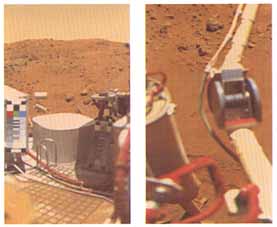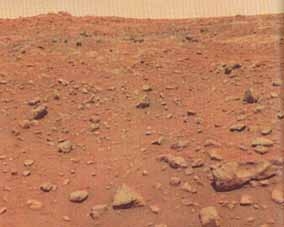SP-425 The Martian
Landscape
Coloring Mars
[132] As we have already
discussed in the introductory text, the problems in reconstructing
the colors of the martian surface and atmosphere are formidable. It
would be nice to present a folio of color pictures with the
unqualified comment that these are the colors of Mars. But, after
more than a year of analysis, it becomes clear that the situation
will never become so simple.
In order to correct for the out of band
spectral leaks in the color filters within the camera it is necessary
to have access to both a color and an infrared (JR) picture taken at
the same time. Only in that way can the IR contributions to the
visible color, a result of camera filter design, be assessed. For the
many color pictures taken without an IR companion (e.g., figs. 186,
192, and 198) detailed calibration is not possible. Instead, the
three visible channels-blue, green, and red-are balanced on the
assumption that there are no out of band contributions.
Even for pictures where we have both visible
and IR information, two possible types of color can be created. The
character of the sunlight reaching the martian surface is
significantly different than that reaching Earth's surface, primarily
because of scattering and absorption by suspended dust particles. In
addition, a certain amount of light reflected from the yellowish
brown surface finds its way back as reflected sky light.
Figures 181, 182, and 183 illustrate the range
of possible color reconstructions. All three pictures are based on
the same camera data. The sampling area at the Viking 1 site is
shown. Two trenches in the Sandy Flats site, the first to be dug are
shown at the far left. Figure 181 is produced by using only visible
color information, making no allowance for IR leaks. The scene has a
reddish or orangeish cast. Figure 182 is constructed by incorporating
data from an accompanying IR picture and using the spacecraft's test
charts, in this way accounting for out of band contributions and
atmospheric colorations. The scene is shown as it might appear "on
Earth." For example, if you could pick up one of the boulders and
transport it to your back yard, this is the color you would observe.
Note that, relative to figure 181, the reddish tint is subdued,
replaced with a brown hue. Figure 183 shows the scene as it would
appear "on Mars." The yellowish cast of sunlight filtering through
the atmospheric dust imparts a similar yellowish hue to the entire
scene.
 Figure 181
Figure 181
|
 Figure 182
Figure 182
|
 Figure 183
Figure 183
|
[134] Figure 184 is a
view looking across Lander 1. Two test charts are visible. The one at
the left is directly illuminated; the colors of the red, green, and
blue color chips are accurately rendered. The test chart to the right
is in shadow and, consequently, of little value for color
calibration.
Figure 185 shows the landscape to the left of
the region in figures 181 to 183. Drifts of sediment are visible in
the distance. Footpad 2, at the bottom of the image, is buried by
yellowish brown soil.
Figure 186 is a historic picture, the first
color image to be taken on the surface of Mars. Because there was no
accompanying IR image, it is not possible to compensate for
irregularities in the camera color filters. The color has the same
relative quality as in figure 181.
 Figures 184 [Left]
& 185 [Right]
Figures 184 [Left]
& 185 [Right]
|
 Figure 186
Figure 186
|
Figure 187 (as on Mars) and figure 188 (as on
Earth) show the landscape in the vicinity of the large dark rock,
"Big Joe." Note that the boulder has a crown of fine grained
material. Exactly how this mantle formed is a puzzle. It may be an
erosional remnant of a dust layer which formerly covered the region
with a thickness of a meter or more.
- [135]
|
-

-
- Figure
187
|
-

-
- Figure
188
|
 Figures 189, 190,
191, 192 [Left to right]
Figures 189, 190,
191, 192 [Left to right]
|
 Figure 193
Figure 193
|
 Figures 194, 195
[Left to right]
Figures 194, 195
[Left to right]
|

Figure
196
|
[136-137] Figure
192, taken early in the Viking 1 mission, was nicknamed "The
American Flag Picture" even before it was taken. During the
final months of preparation before the landing NASA managers
took exception to our decision to feature only the Mars
surface in the first few color pictures. In particular, they
emphasized the popular appeal of a color picture looking
back across the spacecraft, the American flag in the
foreground and the martian horizon in the distance. We
temporized; they insisted. Figure 192 was the result. The
photograph is both pictorially attractive and scientifically
useful. The bright ridge in the distance, part of the crater
rim described in figures 77, 78, and 79, catches the morning
Sun. Difficulties in precisely balancing the colors are
indicated by the violet hue of the blue color chip on the
test chart. The relative differences in reflectance that
yield a color image are illustrated by the three constituent
images taken in blue light (fig. 189), green light (fig.
190), and red light (fig. 191).
Figure 193 is a view looking back
across Lander 2. Dark boulders are prominent against the
yellowish brown soil, standing like regularly deployed
sentinels out to the far horizon.
In the course of the martian year an
important surface change was observed at the Viking 2 site.
During the winter months a thin layer of frost formed. This
is documented by comparing two black and white pictures, the
first taken early in the mission in late martian summer
(fig. 194), and the second taken months later in late
martian winter (fig. 195). Patches of receding frost are
visible in the latter picture. During the height of winter,
frost probably covered the entire surface. Figure 196 is a
color image of the frost, looking across the spacecraft. The
colors purposely have been distorted slightly to enhance
color contrast.
The frost persists at temperatures
higher than those required for frozen carbon dioxide (dry
ice). It may be water ice or a carbon dioxide clathrate, a
crystalline mixture of H2O and
CO2.
|
[138]
 Figure 197
Figure 197
|
[139] The region
in front of Lander 2 was photographed many times in color.
In figure 197 the surface sampler shroud contrasts sharply
with the remainder of the scene. Dust clings to the surface
of footpad 3 and the lower part of the leg strut.
Figure 198 illustrates the
operational versatility of the Viking cameras. By generating
special commands we were able to combine operational modes
in ways never envisioned by the original designers. In this
picture the 0.12° color diodes were stepped at
0.04° intervals instead of the usual 0.12°
intervals. The result is a "high resolution" color image in
which spatial resolution approaches that of a black and
white picture for which both aperture and stepping angle are
0.04°. The red and green patches near the rock in the
upper right occur because the three blue, green, and red
images that comprise the color picture were taken on
successive days. In the intervening period the sampling
shovel disturbed the soil. False colors result primarily
from differences in shadow distribution before and after the
sampling event.
Figure 199 can best be assigned to
the special effects category. It illustrates one of the many
ways in which black and white images can be combined and
printed in color to yield unusual patterns. In this instance
an early morning image is assigned the color yellow and a
picture taken in the afternoon is assigned the color blue.
Although colors produced in this way are completely false,
important details in the scene are sometimes favorably
accentuated.
Figures 200 and 202 are a related
pair, nicknamed the "sundown" and "sunset" pictures. Early
in the mission, when it became clear that there was a large
amount of scattering particles in the lower atmosphere, we
realized the potentially dramatic appeal of low Sun
pictures. However, the first priority was to document the
landscape with high resolution and color images. Following
several weeks of successful operation on the martian surface
we relaxed to the point of attempting exotic but high risk
pictures. The sundown picture was taken on sol 30, just 5
min before the sunset picture. The Sun is to the right, only
4° above the horizon. When the sunset picture was taken
the Sun was 2° below the local horizon. The banding in
the sky is an artifact produced by the camera. The
brightness actually changes continuously, moving away from
the Sun, but the natural continuum is divided into
incremental brightness levels by camera electronics. If the
number of quantified brightness levels were much larger,
then the closely spaced steps would more closely approximate
the continuous gradation of the natural scene. The slightly
different color from band to band is also an artifact,
caused by the fact that the brightness boundaries for the
three color channels are not coincident. The general
tendency for the sky to become bluer in the direction of the
Sun is real, caused by dominant short wave length forward
scattering of light in that direction. No planets or stars
are visible in the evening sky. The occasional pinpoints of
color, ...
|
 Figure 198
Figure 198
|
 Figure 199
Figure 199
|
 Figure 200
Figure 200
|
[140]
....especially noticeable in figure 203, are artifacts
caused by noise in data transmission and by mismatching
during image enhancement.
Initially dismissed as little more
than oddity, the sunset picture has been reproduced many
times, especially in its more exotic "stretched" version
(fig. 203). Admittedly, this version is more an art object
than a scientific product. The colors have been specially
enhanced to bring out the detail in the foreground. However,
the visual impact of this computer painted scene is
universal: the martian twilight envelopes the viewer.
Later in the mission the sunset
picture was matched with a sunrise picture at the Viking 2
site (fig.201) Again, the Sun is several degrees below the
horizon. The relatively pronounced blue shading in the sky
is probably a result of early morning ice crystal
fog.
|
 Figure 201
Figure 201
|
 Figure 202
Figure 202
|
 Figure 203
Figure 203
|




















